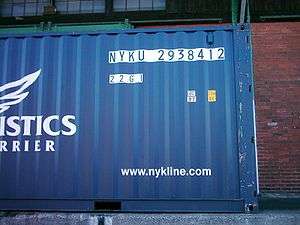Standard Carrier Alpha Code

The Standard Carrier Alpha Code™ (SCAC®) is an US code used to identify road transport companies. It is typically two to four letters long. The National Motor Freight Traffic Association developed the SCAC code back in the 1960s to help road transport companies computerize data and records.[1]
Description
The Standard Carrier Alpha Code, a two-to-four letter identification, is used by the transportation industry to identify freight carriers in computer systems and shipping documents such as Bill of Lading, Freight Bill, Packing List, and Purchase Order. It is also used by the American National Standards Institute, Accredited Standards Committee X12, and United Nations EDIFACT for Electronic Data Interchange computer systems.
SCACs are commonly used by the automobile, petroleum, forest products, and chemical industries; as well as suppliers to retail businesses, carriers engaged in railroad piggyback trailers, and ocean container drayage. SCACs can be obtained online at http://www.nmfta.org.
Freight Carriers who participate in the Uniform Intermodal Interchange Agreement (UIIA) are required to maintain a SCAC. Certain groups of SCACs are reserved for specific purposes. Codes ending with the letter "U" are reserved for the identification of freight containers. Codes ending with the letter "X" are reserved for the identification of privately owned railroad cars. Codes ending with the letter "Z" are reserved for the identification of truck chassis and trailers used in intermodal service.
SCAC is also used to identify an ocean carrier or self-filing party, such as a freight forwarder, for the Automated Manifest System used by US Customs and Border Protection for electronic import customs clearance and for manifest transmission as per the USA's "24 Hours Rule" which requires the carrier to transmit a cargo manifest to US Customs at least 24 hours prior to a vessel's departure at port of loading.
Widely used SCACs
The following is a list of widely used SCACs:[2]
| SCAC | Carrier name |
|---|---|
| ALLV | ALLIED VAN LINES |
| ARFW | AMERICAN FREIGHTWAYS |
| BAXG | BAX GLOBAL |
| BNAF | BAX GLOBAL (air) |
| CBNP | CARBONITE LOGISTICS |
| CDNK | Celadon |
| COSU | Coscon Container Lines |
| COTO | Country Transport |
| ELOI | Ease Logistics |
| CSXT | CSX TRANSPORTATION |
| CWCE | CON-WAY CENTRAL EXPRESS |
| CWIM | CON-WAY INTERMODAL |
| CWSE | CON-WAY SOUTHERN EXPRESS |
| CWWE | CON-WAY WESTERN EXPRESS |
| DMLI | Diamond Logistics |
| DOLR | DOT-LINE TRANSPORTATION |
| EGLV | Evergreen |
| EWCF | EMERY WORLDWIDE |
| EXPD | Expeditors International Ocean |
| FDCC | FedEx Custom Critical |
| FDEG | FEDEX GROUND |
| FDEN | FEDEX (AIR) |
| FEXF | FedEx Freight |
| FXFE | FedEx LTL Freight East |
| FXFW | FedEx LTL Freight West (formerly VIKN - Viking) |
| FXNL | FedEx Freight National (formerly Watkins) |
| GMLS | R and L Carriers |
| HOYO | HOYER Deep Sea |
| INML | INTERMODAL SERVICES |
| KHNN | KUEHNE + NAGEL |
| LDYN | Logistic Dynamics, Inc. |
| MAEU | Maersk Line |
| MCPU | MCC Transport Singapore Pte Ltd. |
| MGMC | MGM TRANSPORT |
| MTEN | Marten Transport LTD. |
| NAFT | NATIONAL FREIGHT |
| NXPL | National Xpress Logistics |
| NYKS | NYK |
| ODFL | OLD DOMINION FREIGHT LINE |
| OOLU | Orient Overseas Container Line |
| PAYL | PAYSTAR LOGISTICS |
| PDME | PIEDMONT EXPRESS |
| PLGQ | Precision Logistics Group |
| RDSS | Rail Delivery Services, Inc. |
| SAFM | Safmarine |
| SCNN | SCHNEIDER NATIONAL |
| SNLU | Schneider National |
| SWFT | SWIFT TRANSPORTATION |
| TCKM | Truckers America |
| TPNW | Triple A Logistics |
| UDRY | USAW - USA Logistics |
| UPGF | UPS FREIGHT (FKA Overnite Transportation Co / OVNT) |
| UPSN | United Parcel Service |
| UPSS | United Parcel Service |
| UPSC | United Parcel Service |
| UPSZ | United Parcel Service |
| USAU | U.S. Government |
| USAX | U.S. Government |
| UQEP | UNIQUE EXPRESS |
| USIT | USA Truck |
| USNW | U.S. Northwest Express or USNW Express |
| USPS | United States Postal Service |
| USXI | U.S. Xpress |
| VLOQ | VANEDGE LOGISTICS |
| VSRD | Vistar Transportation Ltd. |
| XPOL | XPO Logistics |
See also
- Bill of Lading
- EDIFACT
- Electronic Data Interchange
- ISO 6346, an international standard for marking intermodal containers
- Less than truckload
- National Motor Freight Traffic Association
- Reporting mark
References
- ↑ National Motor Freight Traffic Association, Inc. (n.d.). "Standard Carrier Alpha Codes". NMFTA. Retrieved March 25, 2016.
- ↑ EDI Provider (n.d.). "SCAC Codes". EDI Provider. Retrieved March 25, 2016.